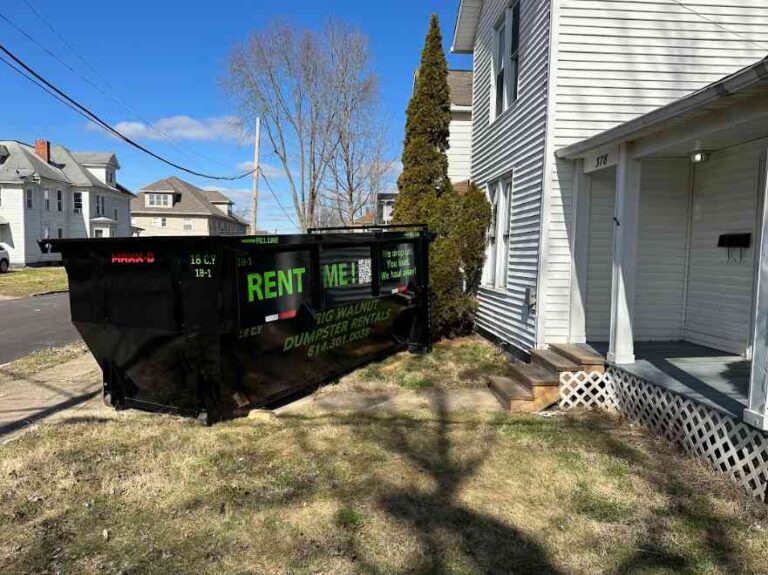Ever stood in the middle of your half-demolished kitchen wondering where all that broken tile is supposed to go? You’re not alone.
Home renovations create mountains of trash, and your regular garbage bin won’t cut it.
That’s where rental dumpsters and waste bins come in handy.
But picking between dumpster rentals, waste bin rentals, and those popular 6-yard dumpsters can feel like choosing between paint colors without swatches.
The wrong choice might leave you with overflow issues or money wasted on unused space.
The right choice keeps your project moving smoothly and your driveway or yard from looking like a junkyard.
Let’s figure out which option makes the most sense for your renovation project.
Dumpster Rentals, Waste Bin Rentals, And 6 Yard Dumpsters which one to choose?
Think of these rental options as different-sized boxes for your renovation leftovers.
Dumpster rentals typically come in larger sizes from 10 to 40 yards, ideal for big projects.
Waste bin rentals are usually smaller, ranging from 2 to 8 yards, perfect for modest jobs.
The 6-yard dumpster sits nicely in the middle – not too big, not too small.
Each option has its sweet spot.
Picking the right one means looking at how much stuff you’re tossing, where it needs to go, and how long you’ll need it.
The goal? Make your renovation cleaner, faster, and less stressful.
Dumpster Rentals vs Waste Bin Rentals vs 6 Yard Dumpsters Which one To Choose?
Understanding Your Waste Management Needs
Before renting anything, take a good look at your project.
Are you gutting a bathroom or just replacing some cabinets? The difference matters big time.
For a small bathroom update, you might create 2-3 yards of waste.
A complete kitchen renovation? That could easily fill 10+ yards.
Walk through each phase of your project and ask: What’s coming out? How bulky is it? How heavy?
Don’t forget about timeline either.
A weekend project needs different waste solutions than a month-long renovation.
Most people underestimate their waste by about 30%. Whatever you think you’ll need, round up.
Dumpster Rentals vs. Waste Bin Rentals
The main difference? Size and flexibility.
Traditional dumpsters are the big boys, typically starting at 10 yards and going up to 40.
Waste bins are the smaller cousins, usually maxing out around 8 yards.
Think of dumpsters for major jobs like whole-house renovations or roof replacements.
They handle heavy materials like concrete, shingles, and large furniture pieces without complaint.
The downside? They need plenty of space to sit and for the truck that delivers them.
Waste bins work better for smaller updates, yard cleanups, or garage decluttering.
They fit in tighter spaces and often cost less upfront.
The catch is you might fill them faster than expected.
Rental periods differ too.
Dumpsters typically come with 7-10 day rentals standard, while waste bins might offer shorter 3-5 day options.
This matters if you’re trying to keep costs down on a quick project.
Why 6 Yard Dumpsters Are a Popular Choice
The 6-yard dumpster hits that sweet spot for most homeowners.
It’s big enough to handle a decent-sized project without overwhelming your property.
Picture this: a 6-yard dumpster typically holds about three pickup truck loads of debris.
That covers most bathroom renovations, small kitchen updates, or decent-sized landscaping projects.
6-yard dumpsters are also ideal for short-term rentals, like spring cleaning or moving out of a home.
They’re especially handy when space is tight but you still have a fair amount to throw away.
Most fit comfortably in a standard driveway without blocking everything.
The footprint is manageable while still giving you good capacity.
What can you fit in a 6-yarder? About 70-80 garbage bags, a small bathroom demolition, or roughly 1,500-2,000 pounds of waste.
That’s a lot of renovation debris without going overboard.
How to Choose the Right Dumpster Size
Picking the right size comes down to simple math mixed with a bit of guesswork.
Here’s a quick rule of thumb:
Small projects (single room refresh): 4-6 yard dumpster Medium projects (bathroom remodel): 10 yard dumpster Large projects (kitchen renovation): 15-20 yard dumpster Major projects (whole house renovation): 30-40 yard dumpster
Consider the type of waste too.
Heavy stuff like concrete and dirt fills up weight limits before space.
A 10-yard dumpster might only handle half its volume in concrete before hitting weight restrictions.
Don’t forget about bulky items either.
That old cast iron bathtub takes up significant space but can be surrounded by smaller debris.
Doors, cabinets, and large furniture pieces create “air gaps” unless broken down first.
When in doubt, go one size up.
The cost difference between sizes is often less than the cost of ordering a second dumpster if you run out of room.
Budgeting for Dumpster and Waste Bin Rentals
Rental costs vary widely based on your location and what you’re tossing, but here’s what affects the bottom line:
Size: Naturally, bigger dumpsters cost more.
Duration: Most rentals include 7-10 days. Extra days mean extra dollars.
Distance: The further the dumpster company travels, the more you’ll pay.
Weight limits: Every dumpster has one. Go over and fees pile up fast. Prohibited items: Some materials cost extra or require special handling.
For a basic 6-yard dumpster, expect to pay between $200-$350 in most areas.
Larger 20-yard options typically run $350-$450.
Waste bins usually start around $100-$200 for smaller sizes.
Watch out for hidden fees. Some companies charge for delivery, pickup, or “fuel surcharges.”
Always ask for the all-in price including taxes and any potential overage fees.
If you’re trying to save money, consider sharing with a neighbor who’s also renovating.
Many companies don’t mind as long as the weight limits are respected.
How Placement Affects Convenience and Safety
Where you put your dumpster or waste bin matters more than you might think.
The ideal spot balances easy access with minimal disruption.
Driveways are popular choices, but concrete can crack under heavy loads. If using your driveway, ask about plywood protection for the surface.
Street placement might require permits from your city or town, which can take days to process.
Keep the dumpster within 50 feet of your work area if possible.
Every extra step adds time and effort when you’re hauling heavy debris.
Make sure doors or gates open correctly with the dumpster in place.
Safety-wise, never place dumpsters under power lines or low-hanging tree branches.
Keep them away from sprinkler systems and septic fields too.
And always check for clearance – the delivery truck needs about 60 feet of straight access to place the dumpster properly.
During longer rentals, consider covering the dumpster overnight with a tarp.
This prevents random people from adding their trash to your paid space.
Maximizing Waste Disposal Efficiency
Getting the most from your rental requires smart loading.
Start with flat, heavy items on the bottom.
This creates a solid base and maximizes space.
Break down bulky items like furniture and cabinets rather than tossing them in whole.
Fill gaps with smaller debris.
Those nooks between bigger items are perfect for bags of trash or smaller construction waste.
Walk inside the dumpster if it has a loading door to arrange things more efficiently.
Keep prohibited items out from the start. Common no-nos include:
- Hazardous materials (paint, solvents, chemicals)
- Electronics and appliances with refrigerants
- Tires
- Mattresses (or they require extra fees)
- Batteries
Sort as you go. Keep recyclables separate from genuine trash. Many renovation materials like metal, clean wood, and cardboard can be recycled instead of landfilled.
Eco-Friendly Home Renovation Waste Solutions
Even with a dumpster, you can keep your renovation green.
Start by asking rental companies about their recycling practices.
Many now sort waste after collection, diverting recyclables from landfills.
For materials in good condition, consider donation before disposal.
Habitat for Humanity ReStores accept cabinets, fixtures, and building materials.
Local theater groups often want old furniture for stage sets.
Some specialized materials have their own recycling channels.
Old carpet can go to carpet recycling programs.
Clean drywall scraps might be accepted by garden centers as soil amendments.
When buying new materials for your project, look for options with recycled content.
This creates demand for the very materials you’re trying to keep out of landfills.
Ask about LEED certification if your project is larger.
Points for waste management might apply, potentially increasing your home’s value.
Common Mistakes to Avoid
The biggest blunder? Underestimating your waste.
Nothing halts a renovation faster than a full dumpster with nowhere for new debris to go.
Waiting until the last minute to rent can leave you without options or paying premium prices.
Book at least a week ahead during busy seasons like spring and summer.
Ignoring weight limits will hit your wallet hard.
Overage fees can add hundreds to your final bill. Know what your materials weigh and stay within limits.
Watch what others put in your dumpster too.
An unattended dumpster might attract neighbors looking to dispose of their own stuff on your dime.
Keep it covered when not in use.
Don’t forget about timing either.
Having the dumpster arrive too early means paying for days you’re not using it.
Too late and debris piles up, creating safety hazards and slowing work.
Conclusion
Picking between dumpster rentals, waste bin rentals, and 6-yard dumpsters comes down to matching the container to your specific renovation needs.
Take time to estimate your waste accurately, consider your space limitations, and understand the true costs involved.
The 6-yard option works well for many home projects, offering that balance of capacity and convenience.
Larger renovations might need the big 20 or 30-yard models, while quick, small updates could get by with a waste bin rental.
Whatever you choose, proper planning keeps your renovation moving forward without the stress of wondering where all that debris will go.
Your future self will thank you for getting this detail right from the start.



